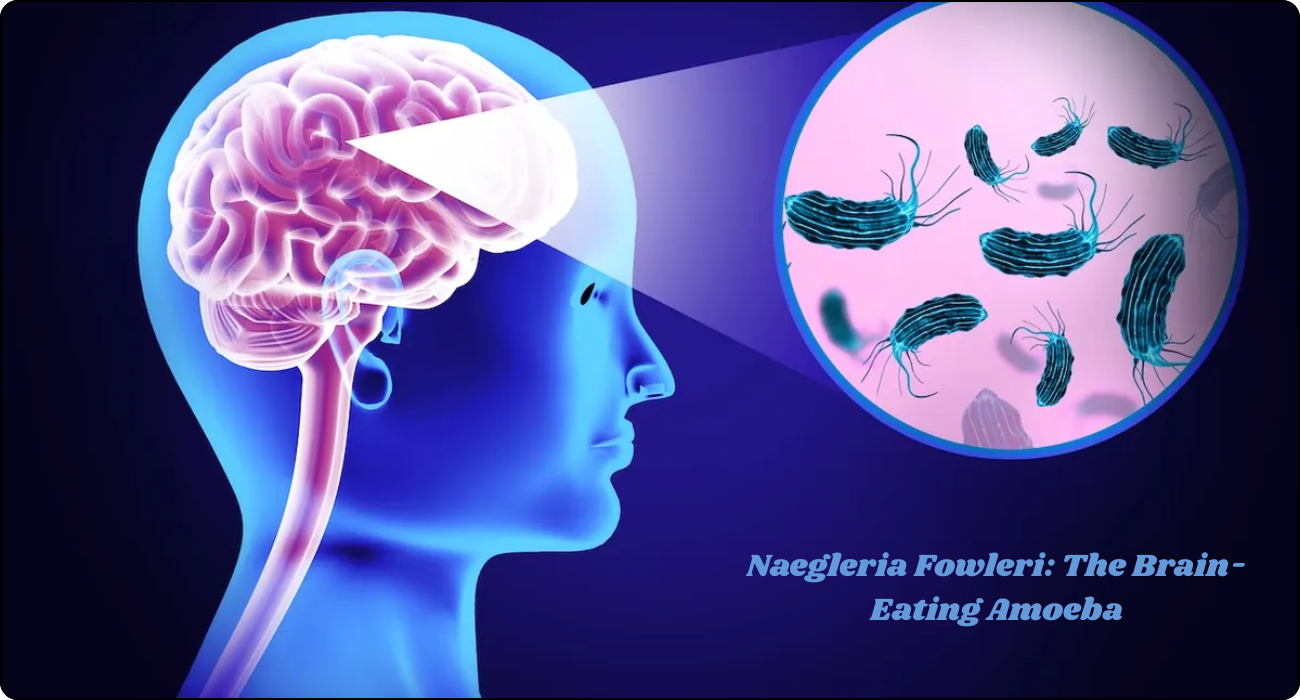Discover essential information about Naegleria fowleri, the brain-eating amoeba. Learn about its lifecycle, symptoms of infection, risk factors, treatment, and prevention strategies in warm freshwater environments.
Naegleria Fowleri: The Brain-Eating Amoeba Explained
Naegleria fowleri, often referred to as the “brain-eating amoeba,” is a microscopic, single-celled organism that can cause a rare but devastating brain infection called primary amoebic meningoencephalitis (PAM). Though naturally occurring in warm freshwater sources, this amoeba becomes highly dangerous when it enters the human body through the nose.
What is Brain-Eating Amoeba?
Brain-Eating Amoeba belongs to the phylum Percolozoa and is part of a group known as amoeboflagellates—organisms capable of shifting between amoeba and flagellate forms. It typically survives by feeding on bacteria found in freshwater environments. However, in extremely rare cases, it becomes pathogenic in humans, entering through the nasal passages and attacking the brain.
Where is Brain-Eating Amoeba Found?
This amoeba thrives in warm freshwater environments. Common sources include:
-
Lakes and rivers during hot weather
-
Geothermal springs and hot tubs
-
Poorly chlorinated or unmaintained swimming pools
-
Industrial or power plant water discharge
-
Water heaters and tap water pipelines
It cannot survive in saltwater and is sensitive to low temperatures, drying, and high acidity.
Also Read: IMSc Recruitment 2025 Scientific Officer Begins – Apply Online for Electrical Post
Lifecycle: Three Forms of Brain-Eating Amoeba
1. Trophozoite (Infectious Stage):
This is the active, feeding stage and the only one that infects humans. Trophozoites multiply rapidly in warm environments (25–42°C) and travel through the nasal cavity to the brain via the olfactory nerve.
2. Flagellate Stage:
Triggered by a change in ionic conditions (such as entering distilled water), the amoeba grows two whip-like tails (flagella) to move. This form is not found in human tissues but can convert back into the infectious trophozoite in nasal passages.
3. Cyst Stage:
In unfavorable conditions like food scarcity or cold temperatures, the amoeba forms a hard, protective shell called a cyst to survive. It becomes dormant until conditions improve.
How Does Infection Happen?
Human infection occurs when contaminated water enters the nose, usually during:
-
Swimming or diving in warm freshwater
-
Bathing or nasal rinsing with untreated water
-
Water sports like jet skiing or wakeboarding
The amoeba enters through the nasal cavity, crosses the cribriform plate, and reaches the brain. Notably, drinking contaminated water does not cause infection.
Symptoms of PAM (Primary Amoebic Meningoencephalitis)
Early symptoms appear within 1–12 days of exposure and may resemble common viral meningitis, making early diagnosis difficult. These include:
-
Fever
-
Headache
-
Nausea and vomiting
-
Loss of appetite
-
Stiff neck
As the infection worsens:
-
Confusion
-
Seizures
-
Hallucinations
-
Coma
-
Death usually occurs within 1–2 weeks.
PAM is extremely rare and nearly always fatal if not treated immediately.
Diagnosis and Treatment
Diagnosis is often delayed because early symptoms mimic other conditions. Confirming Naegleria fowleri requires:
-
Cerebrospinal fluid (CSF) analysis
-
Amoeba cultures
-
Real-time PCR (polymerase chain reaction)
Treatment Options:
-
Amphotericin B: Main antifungal drug used to attack the amoeba’s cell membrane.
-
Miltefosine: An experimental antiparasitic drug that disrupts the organism’s survival signals.
-
Dexamethasone & Therapeutic Hypothermia: Used to control inflammation and brain swelling.
Despite these treatments, the survival rate remains under 3%.
Also Read: Tata Motors Air Conditioning Trucks: A Competitive Standard Feature in All Indian Trucks
How to Prevent Brain-Eating Amoeba Infection
With over 40% of known global cases reported in the U.S., especially in warmer regions, prevention is key. Here are some safety tips:
For Swimmers:
-
Avoid swimming in warm freshwater during hot weather.
-
Wear nose clips to prevent water from entering the nose.
-
Refrain from jumping or diving into warm lakes or ponds.
-
Avoid disturbing the sediment at the bottom of freshwater bodies.
For Nasal Irrigation (e.g., Neti Pots):
-
Use only distilled, sterile, or previously boiled water.
-
Never use tap water directly.
Ecological Impact and Human Risk
Brain-Eating Amoeba flourishes in disturbed ecosystems, especially where thermal pollution reduces competition from other organisms. This enables it to thrive in manmade or altered environments like hot springs, industrial discharges, and artificially heated water bodies.
A study conducted in Wyoming’s Grand Teton National Park confirmed the presence of N. fowleri in several hot springs, particularly those with temperatures exceeding 40°C. This supports evidence that the amoeba is more prevalent in high-temperature, bacteria-rich waters.
Although Brain-Eating Amoeba infections are extremely rare, they are almost always deadly and require immediate medical intervention. Raising awareness, especially during summer activities involving freshwater, is crucial. Following simple safety precautions—like using sterile water for nasal cleansing and avoiding water entering the nose—can significantly reduce the risk of exposure.
